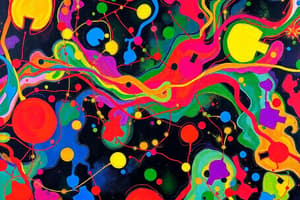Podcast
Questions and Answers
Where does photophosphorylation occur in the chloroplast?
Where does photophosphorylation occur in the chloroplast?
- Stroma
- Thylakoid membrane (correct)
- Inner membrane
- Outer membrane
What is the primary pigment that absorbs light energy in photophosphorylation?
What is the primary pigment that absorbs light energy in photophosphorylation?
- Carotenoids
- Xanthophylls
- Phycobilins
- Chlorophyll (correct)
What is the high-energy electron donor generated by photosystem I?
What is the high-energy electron donor generated by photosystem I?
- NADPH (correct)
- ADP
- NADP+
- ATP
What is the main byproduct of photosynthesis?
What is the main byproduct of photosynthesis?
Which process is responsible for the synthesis of ATP in the light reactions of photosynthesis?
Which process is responsible for the synthesis of ATP in the light reactions of photosynthesis?
What is the primary function of Photosystem II in photosynthesis?
What is the primary function of Photosystem II in photosynthesis?
What is the role of NADPH in photosynthesis?
What is the role of NADPH in photosynthesis?
What is the function of the electron transport chain in photosynthesis?
What is the function of the electron transport chain in photosynthesis?
What is the initial step in the light reactions of photosynthesis?
What is the initial step in the light reactions of photosynthesis?
What is the main source of energy for the cell in the light reactions?
What is the main source of energy for the cell in the light reactions?
What is the role of water molecules in the light reactions of photosynthesis?
What is the role of water molecules in the light reactions of photosynthesis?
Where do the light reactions of photosynthesis take place?
Where do the light reactions of photosynthesis take place?
Flashcards are hidden until you start studying
Study Notes
Light Reactions: The Power of Sunlight in Photosynthesis
Photosynthesis is the process by which plants, algae, and some bacteria convert carbon dioxide (CO2) into glucose (C6H12O6), releasing oxygen (O2) as a byproduct. This process is essential for life on Earth, as it produces the food and oxygen that support the vast majority of species on the planet. However, photosynthesis is a complex process that involves multiple steps, including the light reactions and the dark reactions. This article focuses on the light reactions, specifically the processes of photophosphorylation, photosystem I, photosystem II, and the electron transport chain, which are crucial for the generation of ATP.
Photophosphorylation
Photophosphorylation is the process by which ATP is produced through the conversion of light energy into chemical energy. It occurs in the thylakoid membrane of the chloroplasts, where light energy is absorbed by pigments, primarily chlorophyll, and is used to pump hydrogen ions across the membrane. The result is a buildup of hydrogen ions on one side of the membrane, which leads to the synthesis of ATP through a process known as chemiosmosis.
Photosystem I
Photosystem I is the first of two photosystems involved in the light reactions of photosynthesis. It is responsible for absorbing light energy from the sun and using it to generate a high-energy electron donor called NADP+ (nicotinamide adenine dinucleotide phosphate) through a process called photoreduction. The resulting NADPH is then used in the Calvin cycle, the dark reactions of photosynthesis, to produce glucose.
Photosystem II
Photosystem II is the second photosystem involved in the light reactions of photosynthesis. It is responsible for absorbing light energy and using it to generate a high-energy electron acceptor called NADP+ through a process called photoreduction. Photosystem II is also responsible for splitting water molecules into oxygen gas and hydrogen ions, which are used to generate ATP through photophosphorylation.
Electron Transport Chain
The electron transport chain is a series of complexes that facilitate the transfer of high-energy electrons from one molecule to another, releasing energy in the process. In the context of photosynthesis, the electron transport chain is responsible for transferring electrons from the high-energy electron donors produced by Photosystem I and II to a final electron acceptor, ultimately resulting in the synthesis of ATP through photophosphorylation.
In conclusion, the light reactions of photosynthesis, including photophosphorylation, photosystem I, photosystem II, and the electron transport chain, are essential for the conversion of light energy into chemical energy, which is then used to produce ATP and glucose. These processes are crucial for the survival of plants, algae, and some bacteria, as well as for the entire ecosystem of life that depends on them.
Studying That Suits You
Use AI to generate personalized quizzes and flashcards to suit your learning preferences.




